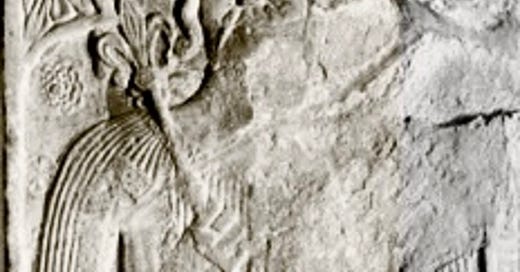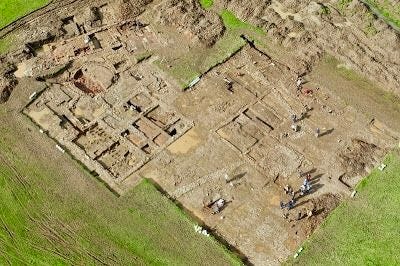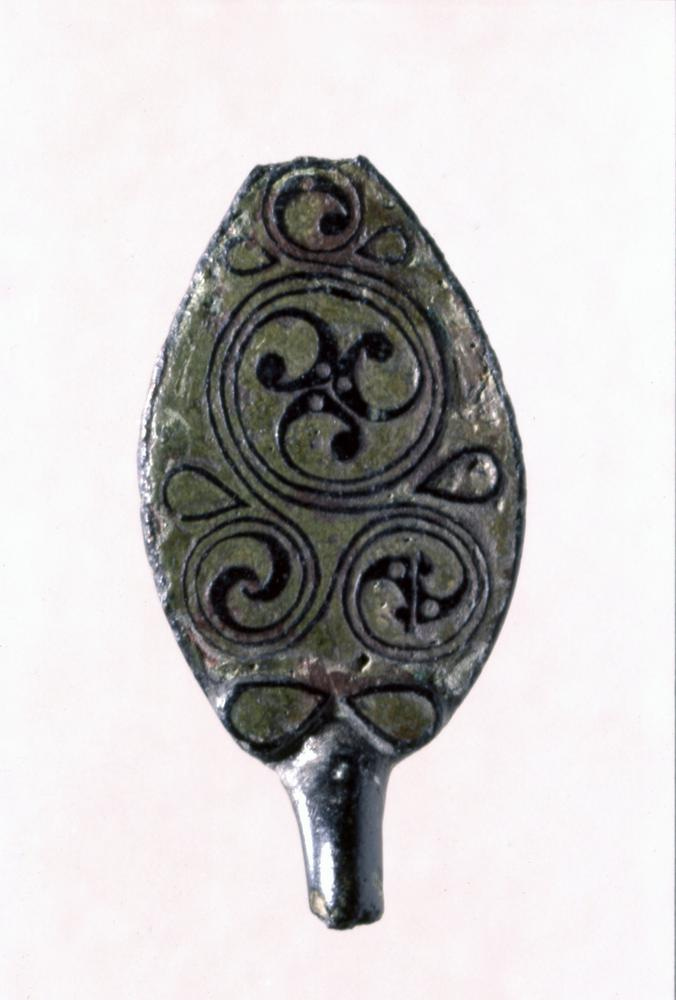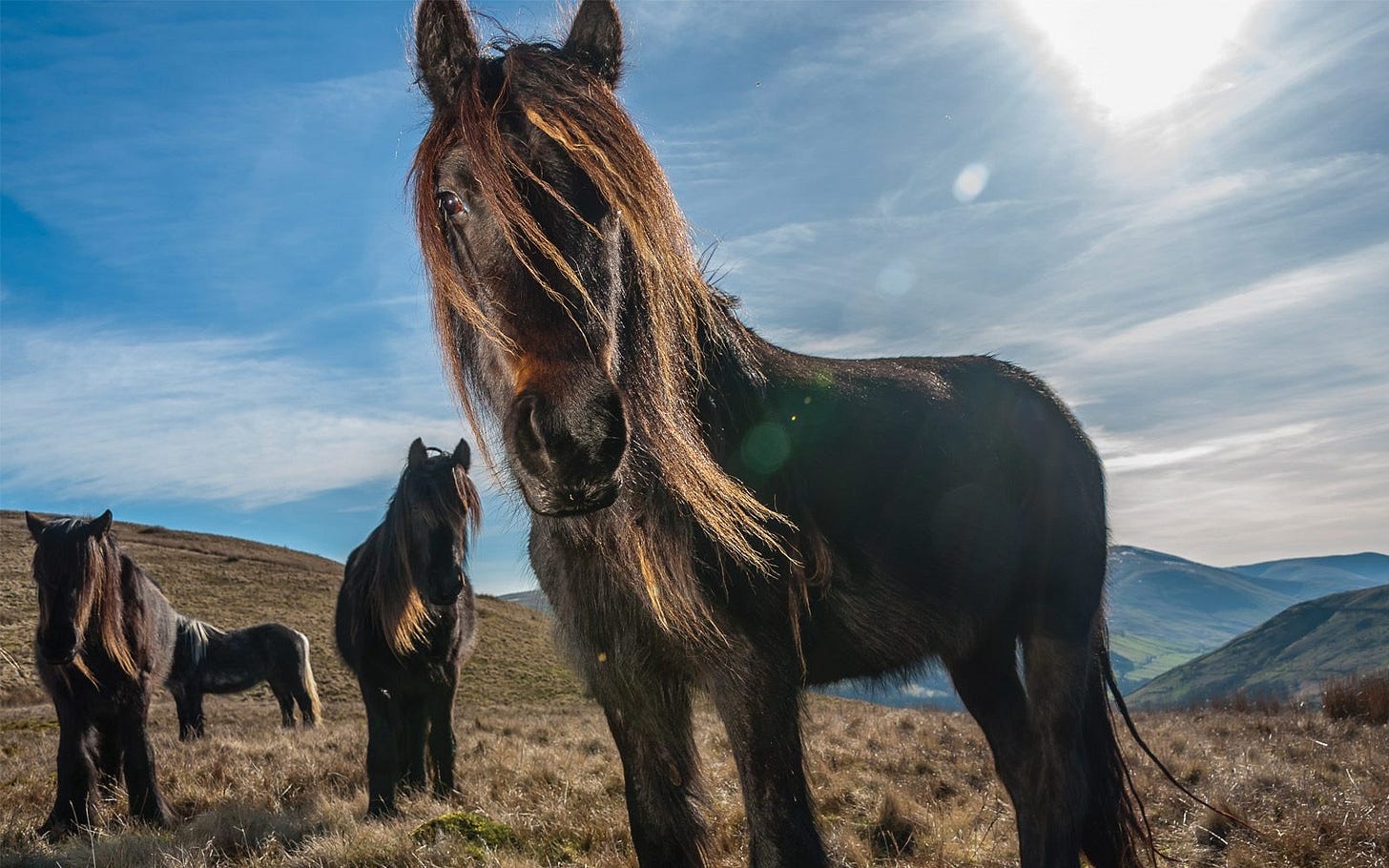The forgotten king of Papcastle rides again
Pabo Post Prydain was a fierce sixth century Celtic king reputed to have ruled part of Cumbria from the abandoned Roman fort of Derventio after the legions departed.
When people speak of Papcastle they are often thinking of the magnificent Roman fort called Derventio that was uncovered there in a televised archeological dig a mile north of Cockermouth in Cumbria.
But few of them realise that after the fall of Rome in 410 AD the original inhabitants of Northern England seized back power. These were the indigenous Celtic Britons who had lived in what is now known as Cumbria for more than three thousand years before the Romans set foot in the place.
Many historians are convinced that one of the greatest Celtic kings who led these people chose to build his power base on what was previously believed to have been the abandoned Roman fortifications in Papcastle. This fierce King was called Pabo Post Prydain and he was first and foremost a soldier.
He won the accolade “Pillar of Britain” in tribute to the way he repelled murderous raids by the coalition of warlike tribes known as the Picts who were keen to exploit any weakness following the departure of Imperial Rome. The idea of a Roman fort being taken over by a Romano-British leader is not unprecedented.
Archaeologists have suggested the similar Birdoswald fort on Hadrian’s Wall was taken over by a sixth century chieftain known as Ceidio. As archaeologist Francis Pryor established in his book Britain AD, the country did not descend into a Dark Age after the Romans left, there was continuity and Pabo was part of it.
Some experts speculate that the “pap” part of the name Papcastle comes from the name Pabo and castle after the Roman word castrum meaning a military camp or fort. If you think his name looks Welsh, that is because it is. At that time all Celts in Britain spoke a language that we call Old Welsh. Cumbrian people would continue to speak Cumbric, a dialect of Old Welsh, until at least 1300.
Pabo Post Prydain played a major, if slightly tragic role in what turned out to be the dying years of Celtic supremacy in Britain. This is the most difficult period of British history to pin down because there are almost no documents and little archaeological evidence. We are obliged to piece together scattered clues to form a picture of how life might have been.
Banish from your mind any assumption that Pabo and his fellow Cumbrian Celts were primitive woad-wearing barbarians. In fact they saw themselves as upper class horse warriors, or knights, defending a retreating civilisation of enormous value against what some see as an invasion by crude but vigorous Anglo-Saxons. Pabo would have prided himself on being a British aristocrat who had his roots in a magisterial culture that outshone anything the Saxons could point to.
The concept of Romanitas, Roman-ness, remained ingrained in the consciousness of the northern British aristocracy and they had a civilised outlook. There was an educated public opinion in the sixth century that understood Latin. But at the same time contemporary poetry tells us they conducted their lives in accordance with the unchanging structure of Celtic society. Just as unyielding ferocity was the greatest virtue of a warrior in battle, so mild and courteous behaviour was expected at home in the king’s mead hall where he was obliged to comport himself chivalrously towards ladies.
Roman buildings and institutions persisted in the north long after the Romans had departed. The Anglo Saxon historian Bede mentions that Carlisle still had a working Roman aqueduct and what seems to have been a bath complex in 685. The British Celts were conscious of having lived in Britain since the dawn of time. They had built and maintained the great Bronze Age monuments, including the cathedral-like Castlerigg Stone Circle near Keswick, dated at 3,200 BC.
Pabo was the product of an advanced culture. He had access to world-renowned Celtic arts such as metalwork enriched with brightly coloured abstract ornament annd enamel. A fine example of a superbly sophisticated Celtic sword in the La Tene style was dug up in a bog near Embleton, Cumbria, dating to possibly 50 AD.
He and his associates called their homeland Hen Ogledd or “Old North.” Archaeologists have found the remains of amphora containing imported wine and olive oil. Later in life Pabo converted to Christianity, the faith that the Romans had brought to Britain and which took an unusually firm root in the lands either side of Hadrian’s Wall.
Pabo and his retainers lived in what they liked to think of a Roman style, especially when they visited old Roman towns like Carlisle which still maintained a recognisably Romanised population for perhaps a hundred years after the Imperial legions departed. The town still had Roman buildings, manuscripts, streets and defensive walls well into the seventh century. Despite the surface sophistication, however, Pabo was a Celtic warrior-king. British culture was still very much centred around mounted fighters. No doubt their organisation was influenced by the traditions of the crack Roman cavalry units that had been stationed at Carlisle and other forts along the wall.
Horses were central to Pabo’s way of life, and the horse was sacred in Celtic culture. Horses are woven all through Celtic legend and art, figuring prominently in their designs for weapons and jewellery.
The horse was vital for the maintenance and prosperity of these tribal kingdoms, as cavalry mounts, status symbols, and as pullers of ploughs and carts. The wild ponies found on the Lakeland fells today are the descendants of animals from Pabo’s stable yard. Ironically, the classic Montefortino cavalryman’s helmet the Romans used with a neck plate, cheek flaps and a decoration down the centre was originally a Celtic design.
Pabo was probably born in 474 AD, when folk memories of Romans being in Britain were still vibrant, and he was crowned in 500 AD. He inherited a portion of the realm ruled over by his father, Athrwys ap Mor, King of the Pennines. (Pabo’s lifespan covers exactly the period when the mythical King Arthur is supposed to have lived.) This gave him control over part of the central spine of northern Britain, apart from the east and west coasts. Pabo’s choice of Papcastle as his fortress seems shrewd. The massive edifice was two Roman forts, one on top of another.
The second even stronger stone one had been constructed in 160AD over the wood-and-earth original. The site occupies a wonderful strategic position on a hill overlooking a major crossing of the River Derwent and lies strategically between the impenetrable Cumbrian mountains and the vulnerable coastal plain. It sits about nine kilometres (5.5 miles) along the Roman road from the coast at Maryport.
Pabo’s Papcastle HQ was still substantially the same intimidating building that the Romans had left behind. The new king needed the protection of Papcastle’s battlements to face down the growing new threat from the south. The southern Celtic tribes had invited Anglo-Saxons from Germany, Denmark and The Netherlands to come to Britain to help fight the Picts.
But unfortunately there was a dispute over payment. The mercenaries retaliated by inviting their relatives to sail across the North Sea in their distinctive wooden boats with many oars and single sails to settle and colonise what was to become known as “Angle-Land” from 450AD.
Pabo was not to know this, but the Anglo-Saxons would eventually work their way north-east until, by 600AD, they gained the upper hand with the creation of the kingdom of Bernicia (Southern Scotland and Northumberland) and Deira (Yorkshire and Humberside). These two would eventually merge to form the mighty kingdom of Northumbria, whose people would eventually filter into Cumbria.
However, partly because of Pabo’s defensive military campaigns, the Anglo-Saxons would never succeed in dominating the mountainous area we now know as the Lake District to any extent. In fact, Oxford University research using the DNA of 2,039 people has recently proved Cumbria is still inhabited by people who are largely genetically the same ancient British tribes as were here in Pabo’s time, not Anglo Saxons.
Pabo was the grandson of the legendary Coel Hen who had ruled eighty years before. Cole Hen is often described as the Old King Cole of the nursery rhyme. This is fanciful. But he was probably the last of the proxy kings or Duces Britanniarum who ran Britain on behalf of the Romans, and who pledged allegiance to Rome. Cole’s kingdom extended over the whole of the north of England from a line joining Chester and the Wash and up into what is today southern Scotland.
This is a short extract from a fascinating chapter in Secrets of the Crooked River a book about Cumbria, the North Lakes and the town of Cockermouth.
It is on sale at The New Bookshop, Main Street, Cockermouth, Bookends in Keswick and Carlisle, along with Sam Read in Grasmere.
Keep reading with a 7-day free trial
Subscribe to Hidden Cumbrian Histories to keep reading this post and get 7 days of free access to the full post archives.








